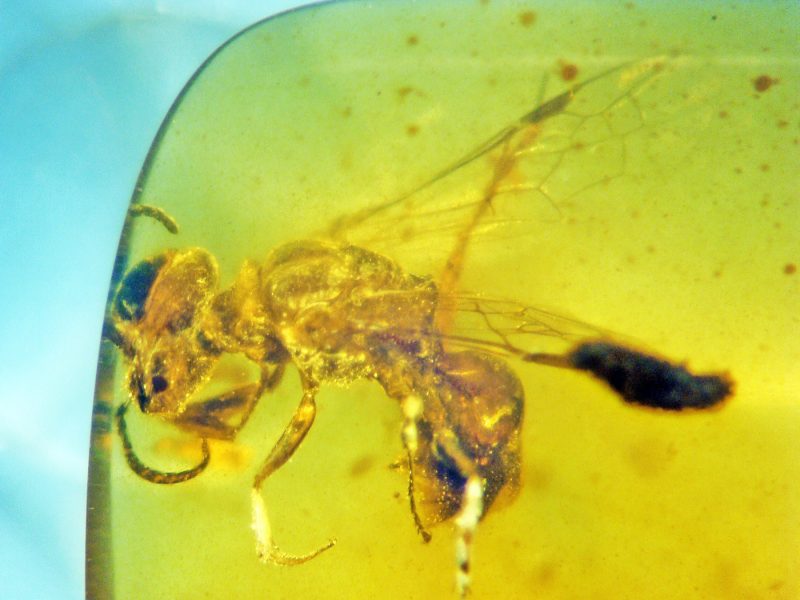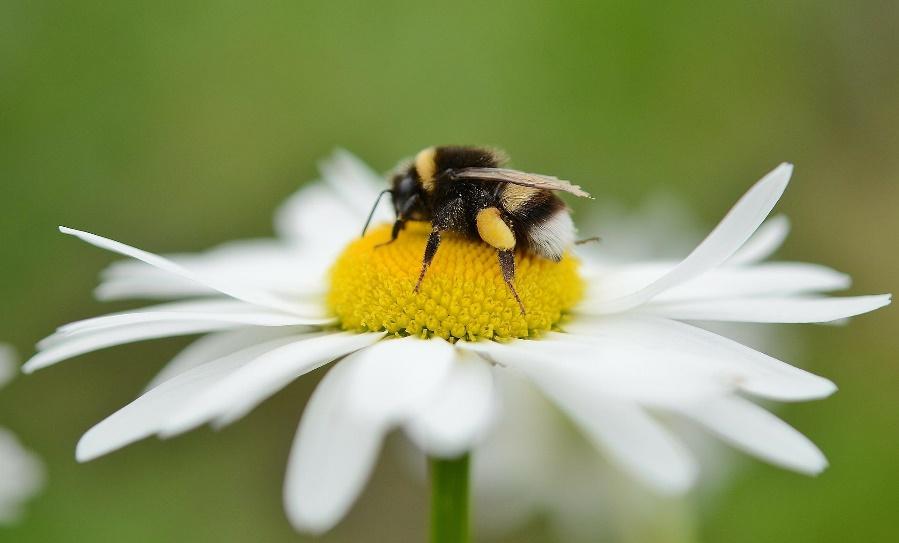Pollinators play an important role in the pollination process, since many flowering plants rely on insect and animal pollinators to reproduce. This article will discuss how bees aid in pollination and what plants they pollinate.
Table of Contents
Bees and Their Pollination Services

Source: George Poinar Jr/Oregon State University
Bees were already buzzing around the planet around 100 million years ago. These ancient bees did not, however, share the same traits as modern bees, as they were carnivorous and originated from hunting wasps. When flowering plants appeared during the Cretaceous period, bees eventually evolved to the environment and began consuming nectar as part of their diet. In turn, many flowers adapted to attract bees in order to increase their chances of pollination. Today, bees are one of the most important pollinators, contributing to the reproduction and survival of flowering plants all over the world.
Today, bees are responsible for pollinating around 80% of the world’s flowering plants; most of the plants we know would face extinction without the help of bees, including the fruits and vegetables we commonly consume. Not only do bees pollinate many of the agricultural products we rely on, but they also pollinate a wide variety of non-agricultural plants, aiding in maintaining biodiversity. Let’s dive in and discover which plants bees pollinate.
Today, bees are responsible for pollinating around 80% of the world’s flowering plants; most of the plants we know would face extinction without the help of bees, including the fruits and vegetables we commonly consume. Not only do bees pollinate many of the agricultural products we rely on, but they also pollinate a wide variety of non-agricultural plants, aiding in maintaining biodiversity. Let’s dive in and discover which plants bees pollinate.
Do Bees Pollinate Cactus?

Source: Natural History of Orange County California/Peter J. Bryant
Although cactus flowers are difficult to pollinate due to their shorter blooming period, they are still pollinated by several animal pollinators including hummingbirds, bats, moths, and bees. Cacti are most commonly pollinated by several specific bee species. As the name suggests, a cactus bee is a common pollinator of cactus flowers, where it feeds on nectar and pollen. Cactus bees are vital pollinators for many cactus species, including some cacti species that only grow in North American deserts.

Native honeybees are another bee species that pollinates cactus. When it comes to pollination, honeybees are regarded as the most dominant pollinator bee species, as they pollinate an extremely wide variety of plants. Like cactus bees, honeybees feed on nectar and pollen in cactus flowers, contributing to cactus pollination.
Do Bees Pollinate Corn?

Like many other field crops, corn is most frequently pollinated by wind. However, bees still visit corn plants because they rely on corn pollen as a source of food, especially for their larvae. Bees usually move from one corn plant to another in order to collect pollen grains, which they then carry back to their hives. This activity also contributes significantly to corn pollination, especially when there’s not enough wind to transport the pollen.
Unfortunately, despite the benefits that bees offer to corn farms, bees often come into contact with toxic pesticides that are commonly used in conventional agriculture. These pesticides are rapidly depleting bee populations. While this may not threaten corn populations significantly, as corn relies partially on wind pollination, declining bee populations may severely threaten crops that rely on insect pollination, and thus threaten our ability to produce enough food.
Do Bees Pollinate Roses?

Bees are the most common pollinator of roses, as they are drawn to roses’ sweet fragrances and vibrant colors. Bees commonly choose specific types of roses, like beach roses and wild roses, due to their open petal structures, which provide a better landing spot for bees, and their stronger scents, which attract bees more strongly.
To feed on nectar, bees fly from one rose flower to another. Pollen grains that stick to their bodies are transferred to other flowers as they move, resulting in pollination. However, bees usually avoid red roses since they are not capable of identifying red colors. This leaves red roses more dependent on other animal pollinators.
Read more: What Pollinators Are Attracted to Roses?
Do Bees Pollinate Cannabis?

Source: Happy Mag
Cannabis is regarded as a dioecious plant, which means that each cannabis plant is either a male or a female, rather than having both male and female flowers on a single plant. Pollen must be transported from a male plant to a female plant. Cannabis plants typically don’t require the services of animal pollinators since they are most frequently pollinated by the wind. Cannabis also doesn’t produce vibrant colors or fragrances that pollinators find appealing. While bees don’t pollinate cannabis plants by transferring pollen, bees may still visit cannabis plants as an alternative pollen source when other flowering plants are unavailable in certain seasons.
Because bees are only attracted to male cannabis plants due to their pollen, the chances of cannabis being pollinated by bees are very slim. Bees are not attracted to (and thus rarely visit) female cannabis plants, since they usually don’t produce nectar. Even if a bee gets pollen from a male plant, it is unlikely to then visit a female plant and transfer the pollen.
When bees do ingest pollen from cannabis plants, they are not affected by the psychoactive components of the plant like mammals are. This is because bees and other insects do not have cannabinoid receptors, the receptors in the mammalian brain that provide the psychoactive effects of cannabis when ingested.

Source: Scoop Whoop
Bees don’t make honey from cannabis because nectar is required for creating honey, rather than pollen. However, a French beekeeper managed to train honeybees to produce honey from cannabis resin that they call a “cannahoney”.
Do Bees Pollinate Coffee?
Different types of coffee plants have distinct characteristics that require varying pollination methods. For example, cross-pollination is required for Robusta coffee plants, which rely on wind and insect pollinator services. The Arabica coffee plant, on the other hand, is a self-pollinating plant. It can transfer pollen from the anther to the stigma of the same flower without the assistance of pollinators.

Source: Dino Martins/World Agroforestry Org.
Read more: Self-Pollination vs. Cross-Pollination

Source: Wikipedia/Vinayaraj
Robusta Coffee Plant
Robusta coffee plants cover 20% of global coffee production, and as mentioned above, require the support of pollinators. Bees are one of the main pollinators of Robusta coffee plants, along with other insects and bird pollinators. Coffee farmers usually place beehives near the Robusta coffee field to support pollination. This can also improve their yields and coffee quality.

Source: Wikipedia/Marcelo Corrêa
Arabica Coffee Plant
80% of global coffee production comes from Arabica coffee plants. Because Arabica coffee plants are self-pollinating, they are able to reproduce without the help of pollinators. However, scientists revealed that bees successfully increase the yield of Arabica coffee by up to 50%. Bee pollination may also improve the coffee quality as insect or animal pollinators like bees promote more genetically diverse crops through cross-pollination.
Coffee plants may also be used to determine whether there is a healthy bee population in an area. For example, in the Philippines, the continuous destruction of beehives due to honey hunting reduces the population of bees in certain areas, as they are forced to relocate. As a result of this habitat destruction and the ensuing absence of bees, coffee production in the Philippines continues to decline year after year, as shown on the graph below. Lower coffee yields can act as an effective way to identify decreasing bee populations.

Source: Philippine Department of Agriculture/PSA
Do Bees Pollinate Daisies?

Bees are one of the main pollinators of daisies. Daisies are one of the most well-known flowers in the world, yet the characteristics of daisies are quite unusual. What looks like one daisy flower actually consists of two flowers; the large white petals are one flower, and the center of the daisy is another flower with many florets. These yellow florets are responsible for producing nectar and pollen.
Daisy flowers have sweet fragrances and vibrant colors that attract pollinators, particularly bees. Daisies’ physical qualities are also ideal for bees, since the daisy’s broad flat petals provide an easy landing spot for them, while the center flower produces a large amount of pollen grains with its hundreds of florets. As bees fly from one daisy flower to another to collect pollen and nectar, pollen grains stick to their bodies and are transferred to another flower, resulting in pollination.
Do Bees Pollinate Watermelon?

Source: Garden Eco
Bees are a primary pollinator of watermelon. A vine plant that usually grows on the ground, the watermelon plant is a member of the Cucurbitaceae plant family, along with cucumber and pumpkin. Watermelon plants have both male and female flowers on the same plant. While both male and female flowers are yellow, the male flowers typically bloom first. Cross-pollination is required to transfer pollen from the male flowers to the female flowers. Because of this, watermelons rely substantially on the services of insect pollinators to reproduce.
To produce a perfectly shaped, store-quality watermelon, the three stigma lobes on the watermelon’s female flower must be pollinated equally with approximately 1000 pollen grains. This complex operation would be impossible without the support of pollinators, particularly bees. However, If the pollination process fails to deliver 1000 pollen grains to the stigma lobes of the female flower, the watermelon fruit may grow with deformities.

Source: University of Florida

Source: Michigan State University
As the primary pollinators of watermelons, bees are essential for the agricultural production of high-quality watermelons. In many areas where watermelons are grown such as California, native bees are the most efficient pollinators of watermelons as they begin their daily pollination earlier than any other pollinators, which may help in reaching their “quota” for pollen and nectar collection. However, because native bees are scarce in some locations, farmers are introducing other bee species as substitutes.
